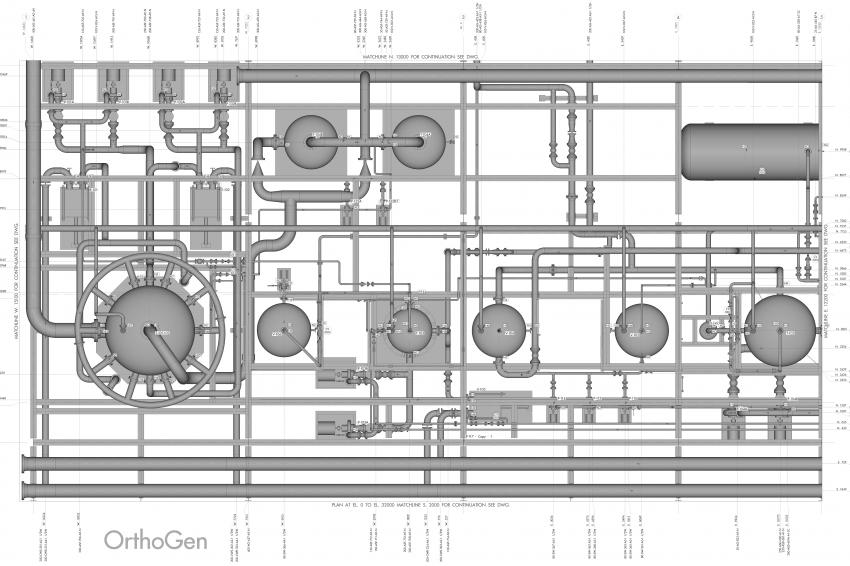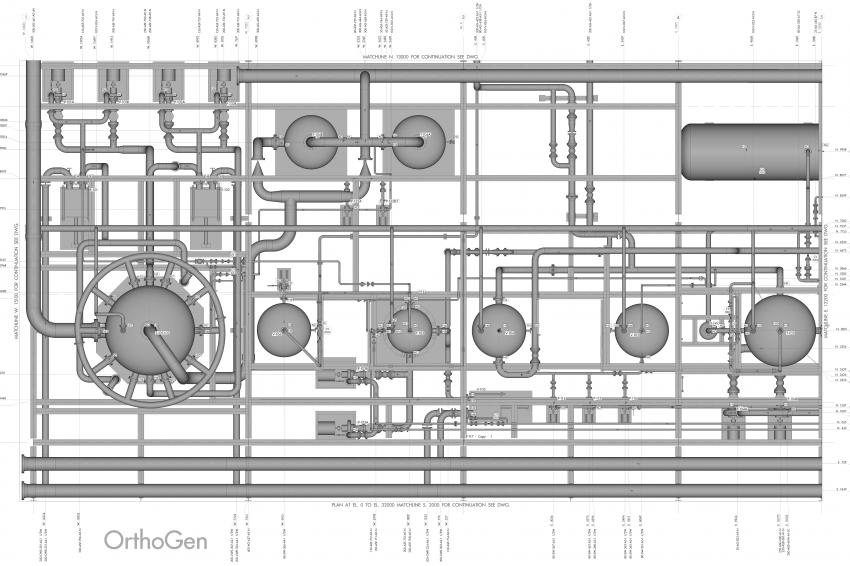Saving Time And Money
Increased Automation of Drawings Pays Off Even in Smaller Projects
Speed And Accuracy - As project schedules and budgets continue to get shorter and tighter, automation will continue to be a key driver in an organization's ability to increase productivity, avoid errors and lower costs. As a significant proportion of the execution time of a small project is dedicated to deliverables creation, this is one focus area that design companies are expecting software vendors to improve.
A plant design project usually requires two primary and essential drawing deliverables to be produced - 2D layouts or general arrangements, and piping isometrics. Whereas layouts and general arrangement drawings will ordinarily show all disciplines in the plant, isometrics on the other hand will only document individual pipelines.
Therefore, for smaller projects that are typically fast-track and low-margin in nature, any 3D plant design solution that can automate the production of both types of deliverable from a 3D model will be highly valuable and attractive to companies who are struggling to cost-effectively produce the deliverables their projects need.
Why is drawing automation attractive? Because automatic drawings generated from 3D models can be created in a fraction of the time of any other means, but more importantly, they always accurately and consistently reflect model conditions, almost eliminating the need to check them.
The design, fabrication and construction of capital projects - such as major industrial facilities including process plants, power stations or offshore platforms - would not be possible without engineering drawings. Documenting the design of these facilities will typically result in literally thousands of drawings being produced throughout the course of a project. Crucial for project success therefore is having the ability to create drawings and reports quickly and accurately, and to be able to update them easily when the design is revised.
Regardless of project size and scope, it's universally understood that process plant design is a spatial task that is best addressed by working in three, rather than two, dimensions. Why is this? A typical plant is an intricate, complex web of interconnecting piping, structure, equipment, instrumentation, electrical and HVAC. Hence executing plant design projects in 2D alone is extremely time consuming, error prone and hugely difficult.
Furthermore, because of the manual nature of the 2D design process, which is predominantly drafting biased, even the smallest projects executed entirely using 2D CAD can be challenging. Even when taking the utmost care and paying close attention to detail, the project will often suffer schedule delays and cost increases due to mistakes and omissions caused by human error. Unfortunately, many of these problems don't come to light until late in the project, when they are both difficult and costly to rectify.
3D Modeling For All
To support the needs of large, multidiscipline design groups, working on large-scale or even mega-sized joint venture projects, often based in different geographical locations around the globe, many software companies in the market have invested heavily in developing high levels of drawing and reporting automation as part of their 3D design solutions. Using these solutions, high-quality deliverables can be generated automatically from the 3D design model at the click of a button, without manual intervention or any need for further editing or touch-up.
But what if you need a solution that is suitable for smaller-scale projects, or don't have the budget to invest in any of the high-end solutions that are available, for that matter? Well, the good news is that a wide range of solutions addresses the needs of engineers, designers and the broad spectrum of small, medium, large and mega-sized projects executed in the process, power and marine industries.
The major players in 2D and 3D modeling are looking after the smaller segment of projects and companies with well-developed AutoCAD-based plant design products. Appropriate for any sized organization, but more so, perfectly suited to smaller design contractors, particularly those who are looking to make the transition from 2D drafting to 3D plant design for the first time, one of those tools in the market is Intergraph's CADWorx Plant Professional. The tool has a user-friendly interface, and in a few days, personnel who are already familiar with AutoCAD can be taught to leverage their existing 2D skills to quickly become proficient and productive in AutoCAD-based 3D plant design.
Some vendors focus on the lower end of the plant design market with their 3D plant design tools that are built on 2D CAD platforms like AutoCAD or MicroStation. In those systems, the production of deliverables is usually highly manual, with responsibility for general arrangement drawing production delegated entirely to the user. However, some systems do offer basic automation to make the drawing creation task easier - such as the ability to add dimensions and labels, and perform hidden line removal on scaled views in paper space, or extract bills of material reports from the 3D model. It is possible to produce good quality deliverables in this way, and it is certainly much easier and less time consuming than drafting deliverables by traditional means in 2D CAD. But most companies who choose to invest in low-end solutions really want fully automated drawing production from the 3D model. This would enable them to increase their productivity and reduce errors. However, so far, attaining complete deliverables automation continues to be the accomplishment of just the high-end systems.
For many years, users of high-end design solutions such as Intergraph's PDS have benefitted from the use of OrthoGen - developed by 3DS Net Inc. for the automatic production of 2D layouts and general arrangement drawings. Low-end system vendors on the other hand have not taken advantage of OrthoGen, and therefore provide only half of the drawing automation capability that design contractors expect to be offered in 3D plant design solutions today. Now Intergraph's CADWorx Plant Professional is the first to break that impasse and is currently the only solution available in the low-end plant design market today to offer OrthoGen.
Millions of drawings for extremely large and complex plant designs across all disciplines - petrochemical, pulp and paper, pharmaceutical, power, offshore, mining and minerals, and shipbuilding projects - are using highly developed automated 3D design tools to accelerate the project process. The same automation levels and productivity boost can now be achieved by smaller companies and projects - and now for AutoCAD-based plant design projects.
Low Cost, User Friendly
Drawings can be created in a fraction of the time they would take to produce manually, even if the process is semi-automated in some way. For example, industry users involved in drawing production activities in major international engineering firms have reported spending 40 to 60 hours per complicated piping drawing using semi-automatic methods. Taking into account the time needed to add other required details - such as hatching, notes and detailed dimensions - these same firms report it taking 2 to 4 hours per drawing supported by OrthoGen automation. A considerable time saving!
The time savings reported have mainly to do with the higher accuracy and consistency of the drawings, which require less double-checking and report fewer errors. Additionally, when changes to the design occur, updates to the drawings are also made automatically when the drawing has been re-run, saving even more time and effort.
Easy configurable options make these tools available to engineers without the burden of expensive training, and drawings meet the most demanding customer requirements. Through the application of standards and use of templates, these design tools enable smaller companies to be completely in control of the deliverables produced for projects. Users can select from a set of predefined drawing types and are able to see a preview of the output, as well as descriptions and tips on the options used for each drawing type.
Complete drawing automation is a key differentiator when choosing a plant design system to ensure projects are delivered with high quality, on time and within budget. Smaller companies have been postponing the decision to join the fully automated drawing generation because of constraints in price or technical accessibility of the tools available in the market.
There is no reason to stay out of the game any longer. Whether you're in the market for a 2D/3D plant design solution for the first time, looking for an alternative or a complementary solution for smaller projects, or looking to move from a low-end to a high-end system, drawing automation is now available to all.
Contact
Intergraph Benelux B.V.
Siriusdreef 2
2132 WT Hoofddorp






